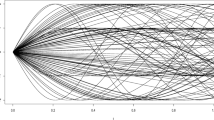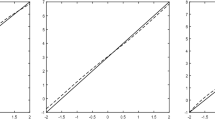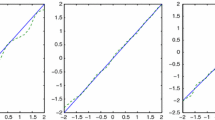Abstract
In this work, we introduce a local linear nonparametric estimation of the regression function of a censored scalar response random variable, given a functional random covariate. Under standard conditions, we establish the pointwise and the uniform almost-complete convergences, with rates, of the proposed estimator. Then, we carry out a simulation study and a real data analysis in order to compare the performances of our methodology with those of the kernel method.





Similar content being viewed by others
References
Ait Hennania, L., Lemdania, M., & Ould Said, E. (2018). Robust regression analysis for a censored response and functional regressors. Journal of Nonparametric Statistics,. https://doi.org/10.1080/10485252.2018.1546386.
Barrientos-Marin, J. Ferraty, Vieu, F., & Vieu, P. (2010). Locally modelled regression and functional data. Journal of Nonparametric Statistics, 22(5), 617–632.
Benhenni, K., Ferraty, F., Rachdi, M., & Vieu, P. (2007). Local smoothing regression with functional data. Computational Statistics, 22(3), 353–369.
Bitouzé, D., Laurent, B., & Massart, P. (1999). A dvoretzky-kiefer-wolfowitz type inequality for the Kaplan–Meier estimator. Annales de l’Institut Henri Poincaré (B) Probabilités et Statistiques, 35, 735–763.
Bouchentouf, A., Hamza, A., & Rabhi, A. (2017). Strong uniform consistency rates of conditional hazard estimation in the single functional index model for dependant functional data under random censorship. International Journal of Statistics and Economics, 18, 82–101.
Chaouch, M., & Khardani, S. (2014). Randomly censored quantile regression estimation using functional stationary ergodic data. Journal of Nonparametric Statistics,. https://doi.org/10.1080/10485252.2014.982651.
Demongeot, J., Laksaci, A., Madani, F., & Rachdi, M. (2013). Functional data: local linear estimation of the conditional density and its application. Statistics, 47(1), 26–44.
El Ghouch, A., & Van Keilegom, I. (2009). Local linear quantile regression with dependent censored data. Statistica Sinica, 19, 1621–1640.
Ferraty, F., Van Keilegom, I., & Vieu, P. (2008). On the validity of the bootstrap in nonpara-metric functional regression. Scandinavian Journal of Statistics, 37(2), 286–306.
Ferraty, F., Laksaci, A., Tadj, A., & Vieu, P. (2010). Rate of uniform consistency for nonparametric estimates with functional variables. Journal of Statistical Planning and Inference, 140, 335–352.
Ferraty, F., & Vieu, P. (2006). Nonparametric functional data analysis. Theory and practice. Springer series in statistics. New York: Springer.
Guessoum, Z., & Ould Said, E. (2008). On nonparametric estimation of the regression function under random censorship model. Statistics & Decisions, 26, 159–177.
Horrigue, W., & Ould Said, E. (2011). Strong uniform consistency of a nonparametric estimator of a conditional quantile for censored dependent data and functional regressors conditional quantile for functionnal times series. Random operators and stochastic equations (pp. 131–156). Basel: Birkhusser Verlag.
Horrigue, W., & Ould Said, E. (2015). Nonparametric regression quantile estimation for dependent functional data under random censorship: Asymptotic normality. Communications in Statistics-Theory and Methods, 44, 4307–4332.
Kadiri, N., Rabhi, A., & Bouchentouf, A. A. (2018). Strong uniform consistency rates of conditional quantile estimation in the single functional index model under random censorship. Dependent Modeling, 16, 197–227.
Kaplan, E. M., & Meier, P. (1958). Nonparametric estimation from incomplete observations. Journal of the American Statistical Association, 53, 457–481.
Kolmogorov, A. N., & Tikhomirov, V. M. (1959). \(\varepsilon\) entropy and \(\varepsilon\) capacity. Uspekhi Matematicheskikh Nauk, 14, 3–86. (Engl Transl American Mathematical Society Translations. Ser 2 (1961) 277–364).
Leulmi, S. (2020). Local linear estimation of the conditional quantile for censored data and functional regressors. Communications in Statistics-Theory and Methods,. https://doi.org/10.1080/03610926.2019.1692033.
Leulmi, S., & Messaci, F. (2018). Local linear estimation of a generalized regression function with functional dependent data. Communications in Statistics-Theory and Methods, 47(23), 5795–5811.
Leulmi, S., & Messaci, F. (2019). A class of local linear estimators with functional data. Journal of Siberian Federal University, 12, 379–391.
Ling, N., & Liu, Y. (2016). The kernel regression estimation for randomly censored functional stationary ergodic data. Communications in Statistics-Theory and Methods,. https://doi.org/10.1080/03610926.2016.1185117.
Mechab, B., Hamidi, N., & Benaissa, S. (2019). Nonparametric estimation of the relative error in functional regression and censored data. Chilean Journal of Statistics, 10(2), 177–195.
Messaci, F., Nemouchi, N., Ouassou, I., & Rachdi, M. (2015). Local polynomial modelling of the conditional quantile for functional data. Statistical Methods & Applications, 24(4), 597–622.
Ould Said, E. (2006). A strong uniform convergence rate of kernel conditional quantile estimator under random censorship. Statistics & Probability Letters, 76, 579–586.
Acknowledgements
The author is very pleased to thank the editor and the reviewers for their helpful suggestions and comments.
Author information
Authors and Affiliations
Corresponding author
Additional information
Publisher's Note
Springer Nature remains neutral with regard to jurisdictional claims in published maps and institutional affiliations.
Appendix
Appendix
In what follows, let C be some strictly positive generic constant and for any \(x\in {\mathcal F}\), and for all \(i=1,\ldots ,n\):
-
1
To treat the pointwise almost-complete convergence of \(\widehat{m}(x)\) we need Lemma A.1 introduced in Barrientos-Marin et al. (2010)
Proof of Lemma 2
As \((X_i,Z_i,\delta _i)\) are i.i.d., we get
Hypothesis (H4), combining with the fact that \(E(\delta _2|X_{2},Y_2)=S(Y_{2})\), give that
Then, we get
The claimed result is obtained by using the last relation and the condition (H2). \(\square\)
Proof of Lemma 3
We need to show that
By following the same decomposition idea as in the proof of Lemma 4.4 in Barrientos-Marin et al. (2010), we can write
where, for \(p \in \{2,3,4\}\) and \(l \in \{0,1\}\),
So, we have
Notice that, \(Q(x)=O(1)\) [see the proof of Lemma 4.4 in Barrientos-Marin et al. (2010)], so, we have to show that, for \(p \in \{2,3,4\}\) and \(l \in \{0,1\}\)
and that almost-surely
and
-
Firstly we have
$$\begin{aligned} M_{p,l}(x)-E(M_{p,l}(x))= & {} \frac{1}{nh^{p-2}\varPhi _{x}(h)} \sum _{i=1}^{n}\left[ K_{i}(x)\beta ^{p-2}_i(x) Z_i^l \delta _i^l S^{-l}(Z_i)-E \left( K_{i}(x)\beta ^{p-2}_i(x) Z_i^l \delta _i^l S^{-l}(Z_i)\right) \right] \\= & {} \frac{1}{n} \sum _{i=1}^{n}\frac{1}{h^{p-2}\varPhi _{x}(h)} \left[ K_{i}(x)\beta ^{p-2}_i(x) Z_i^l \delta _i^l S^{-l}(Z_i)-E \left( K_{i}(x)\beta ^{p-2}_i(x) Z_i^l \delta _i^l S^{-l}(Z_i)\right) \right] \\:= & {} \frac{1}{n}\sum _{i=1}^{n} \eta _i^{(p,l)}(x), \end{aligned}$$where
$$\begin{aligned} \eta ^{(p,l)}_{i}(x) :=\frac{1}{h^{p-2}\varPhi _{x}(h)} \left[ K_{i}(x)\beta ^{p-2}_i(x) Z_i^l \delta _i^l S^{-l}(Z_i)-E \left( K_{i}(x)\beta ^{p-2}_i(x) Z_i^l \delta _i^l S^{-l}(Z_i)\right) \right] . \end{aligned}$$(11)In order to apply an exponential inequality, we focus on the absolute moments of the r.r.v. \(\eta ^{(p,l)}_{i}(x)\). By Lemma A.1(i) in Barrientos-Marin et al. (2010), we can write
$$\begin{aligned} E \vert \eta ^{(p,l)}_{i}(x) \vert ^m = O \left( [\varPhi _{x}(h)]^{-m+1} \right) . \end{aligned}$$Finally, it suffices to apply Corollary A.8-(ii) in Ferraty and Vieu (2006) with \(a^2_n =[\varPhi _{x}(h)]^{-1}\) to get, for \(p \in \{2,3,4\}\) and \(l \in \{0,1\}\)
$$\begin{aligned} M_{p,l}(x)-E M_{p,l}(x)=O_{a.co.}\left( \sqrt{\frac{\ln n}{n\varPhi _{x}(h)}} \; \right) . \end{aligned}$$(12) -
It is easy to see that under (H1), (H3), (H4) and (A1), we get, for \(p \in \{2,3,4\}\) and \(l \in \{0,1\}\),
$$\begin{aligned} E[M_{p,l}(x)]=h^{2-p}\varPhi _{x}(h)^{-1} E\left[ K_{1}(x)\beta ^{p-2}_1(x) Z_1^l \delta _1^l S^{-l}(Z_1)\right] \le C, \end{aligned}$$(13)the last inequality is obtained by using the Lemma A.1(i) in Barrientos-Marin et al. (2010).
-
Treatment of the term \(E(M_{2,1}(x))E(M_{4,0}(x))-E(M_{2,1}(x)M_{4,0}(x))\)
We can write
$$\begin{aligned} E(M_{2,1}(x))E(M_{4,0}(x))-E(M_{2,1}(x)M_{4,0}(x)) = \frac{1}{nh^{2} \varPhi _{x}(h)^{2}} E[ K_1(x) \beta _1^{2}(x)] E[ K_1(x) m(X_1)] +O\left( (n \varPhi _{x}(h))^{-1} \right) . \end{aligned}$$By using Lemma A.1(i) in Barrientos-Marin et al. (2010), it is easy to see that
$$\begin{aligned} E(M_{2,1}(x))E(M_{4,0}(x))-E(M_{2,1}(x)M_{4,0}(x))=O\left( (n \varPhi _{x}(h))^{-1} \right) , \end{aligned}$$(14)which is negligible with respect to \(O\left( \sqrt{\frac{\ln n}{n\varPhi _{x}(h)}} \; \right)\), under (H5).
-
By similar arguments, one can state
$$\begin{aligned} E(M_{3,1}(x))E(M_{3,0}(x))-E(M_{3,1}(x)M_{3,0}(x))=O\left( \sqrt{\frac{\ln n}{n\varPhi _{x}(h)}} \; \right) . \end{aligned}$$(15)
\(\square\)
Proof of Lemma 5
Because the assumption (A1) and the definitions of \(\widehat{m}_{1}(x)\) and \(\widetilde{m}_{1}(x)\) in (6) and (7), we can write
where \(\widehat{m}_0(x)\) is defined in (6).
In order hands, by adapt Theorem 1 of Bitouzé et al. (1999), we get
which is equals to \(O_{a.co.}\left( \sqrt{\frac{\ln n}{n\varPhi _x(h)}}\right)\). The proof is completed by using Lemma 4. \(\square\)
-
2.
To treat the uniform convergence of \(\widehat{m}(x)\) we need to Lemma 4.1 introduced in Messaci et al. (2015)
Proof of Lemma 7
It is a direct proof, by combining Eq. (9) and hypothesis (U2). \(\square\)
Proof of Lemma 8
We use again the decomposition (10) and by following the same steps as in (13), (14) and (15), with using Lemma 4.1 in Messaci et al. (2015) instead of lemma A.1 in Barrientos-Marin et al. (2010), we obtain under the assumptions (U1), (U3), (U4), (U6) and (A1), for \(p=2,3,4\) and \(l=0,1\),
and
which is, in view of hypothesis (U5), equals to \(O\left( \sqrt{\frac{\ln d_n}{n\varPhi (h)}}\right)\).
So, we need to check that for \(p=2,3,4\) and \(l=0,1\),
Now, we consider the following decomposition
Study of the terms \(F_1^{p,l}\) and \(F_3^{p,l }\).
First, let us analyze the term \(F_1^{p,l}\). Since K is supported in [0, 1] and according to (U1), we can write
Let
The assumptions (A1) and (U7), implie that
so, by applying corollary A.8-(ii) in Ferraty and Vieu (2006), with \(a_{n}^{2}=\frac{r_n}{h\varPhi (h)}\),
Applying (19) again (for \(m=1\)), one gets
Combining this equation with assumption (U5) and the second part of the assumption (U1), we obtain
Second, since
we deduce that
Study of the term \(F_{2}^{p,l}.\)
For all \(\zeta >0\), we have that
where \(\eta ^{(p,l)}_{i}\) is defined in (11). By using again Corollary A.8-(ii) in Ferraty and Vieu (2006) and the assumption (U5), we obtain
Finally, the result of Lemma 8 follows from the relations (20), (22) and (21). \(\square\)
Proof of Lemma 10
By the relation (16), we can write
The proof is completed by the relation (17) and Lemma 9. \(\square\)
Rights and permissions
About this article
Cite this article
Sara, L. Nonparametric local linear regression estimation for censored data and functional regressors. J. Korean Stat. Soc. 51, 25–46 (2022). https://doi.org/10.1007/s42952-020-00080-7
Received:
Accepted:
Published:
Issue Date:
DOI: https://doi.org/10.1007/s42952-020-00080-7
Keywords
- Functional data
- Right censoring
- Locally modeled regression
- Nonparametric estimation
- Kaplan-Meier estimator
- Rate of almost-complete convergence




